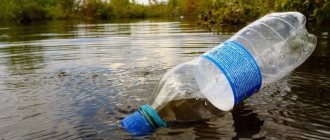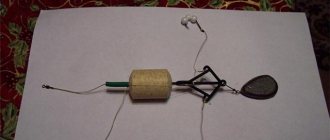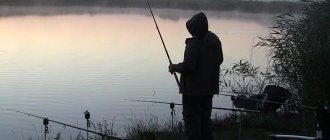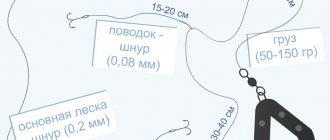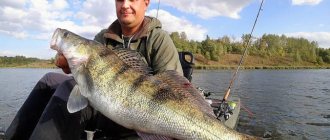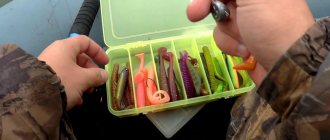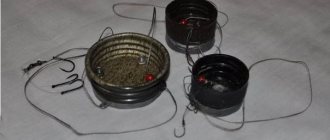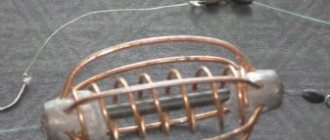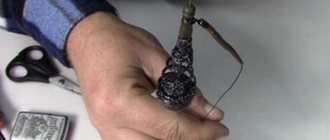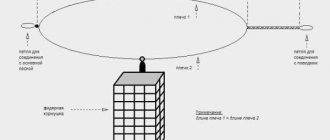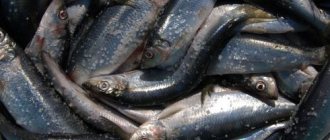Where and when to catch pike perch with live bait
Finding places where pike perch congregate largely depends on the time of year. Also, the best fishing time for pike perch and the effectiveness of fishing depend on the time of year. As they say, fishing begins in the spring, so let’s start looking at catching pike perch with live bait in the spring season.
Pike perch on live bait in spring
In the spring, pike perch spawn. Pike perch begins to spawn when the water temperature reaches 12-15 °C. But immediately before spawning and two weeks after it, the pike perch begins to eat. At this time, he eats everything that moves, the main thing is not to miss the arrival of pre-spawning and post-spawning food.
After spawning, the pike perch will be sick for about two weeks and catching it will be unsuccessful. As soon as the predator takes a break from the spring grater, a new wave of hunger will wash over it again and fishermen will be able to enjoy the excellent bite of pike perch.
In the spring, it is optimal to go fishing for pike perch with an overnight stay. The best biting time will be with the onset of evening and morning twilight - the favorite time of pike perch, almost at any time of the year. That is why pike perch is called a twilight predator. The bite is worse during the day and at night.
In spring, pike perch prefers shallow depths, usually shallow coastal waters. Most of all, pike perch like shallow waters with uneven bottom topography, so if such a place is found, it is better to thoroughly examine it for the presence of a predator.
Pike perch using live bait in summer
In summer, you should look for pike perch in deep holes or in coastal shade. In general, pike perch in the hot season chooses areas where the rays of the hot summer sun cannot reach it.
It comes out to the coastal shallows to hunt in the early morning and late evening. At night, the pike perch bite is possible, but it will be noticeably worse than the twilight one. During the day, the pike perch bite is rather an exception and only small pike perch can be caught.
At the end of summer, you should look for pike perch in the coastal zone, on shallows and steep edges. The best bite is observed at night. It is optimal to start fishing for pike perch with live bait in the evening and continue fishing until the morning. During the day, the pike perch bite stops.
Closer to autumn, the fry that appeared this spring grow up, which is an excellent food for pike perch. Therefore, at the end of summer, pike perch begins to hunt it. Since this fry is in the coastal zone, the predator also goes there.
Pike perch using live bait in the fall
In the fall, pike perch begins to eat again and is actively caught. During this period, fishing is more productive from a boat, as it moves to deep areas of the reservoir, further from the shore. Deep holes are exactly the places to look for pike perch in the fall.
In the autumn season, pike perch can be caught well both day and night. During the day you can often find a group of pike perch in sun-warmed areas of water. If it's cloudy, but a small area of water gets some sunlight, there's a good chance that the pike perch is there. This predator is not averse to basking in the last rays of the autumn sun.
Pike perch using live bait in winter
Pike perch does not lose activity even in winter. The most popular way to catch it in the cold season is with girders. You need to look for the predator along the riverbed, at the exit from bays and in snags.
Anglers know that pike perch always takes the same route and place poles along its intended route. In this way, it is possible to make a very good catch and effectively use all the fishing rods. But not every fisherman knows the route of the pike perch, and searching for it can take more than one year.
The time of day for catching pike perch in winter is practically unimportant. But during the day, during this period, he still bites better
In the dead of winter, pike perch bite extremely reluctantly. The best period for winter fishing for pike perch is the very beginning and end of winter.
Tactics and fishing techniques
When a promising place has been identified, live bait should be caught. It is better not to stock up live bait for future use. They can be caught with a simple fishing rod.
Tips for fisherman: Do-it-yourself bottom tackle for silver carp - Answers for beginners
And you can use airplanes:
- top;
- screens;
- lifts;
- spiders.
Using such devices, you can easily catch the required number of live bait in a short period of time. Most of all, pike perch like small roach and bitterling. You need to attach live bait by two lips. This way it stays alive for a long time and will not fall off when casting the rig.
The equipment should be thrown to the farthest point of a promising location. Within ten minutes, an active predator will reveal itself. If there is no bite during this time, you should play with bait. You need to make two turns of the coil and wait a couple of seconds, then another turn. Then wait a minute and repeat everything. You need to continue this game until the bait leaves the promising place. If there is a fanged robber nearby, he will definitely show himself. Otherwise, you need to look for another suitable place.
This ancient fishing method is still an interesting and productive way of catching pike perch in our time.
Since this type of fishing does not apply to regular fishing, you need to choose the right place, and for this it is advisable to know where pike perch usually hangs. Spinners know such places, and in this sense it is easier for them. This method is used from the second half of June until the end of October. In mid-autumn you can take out the spinning rod again. The fish go to deeper places, so catching them with live bait becomes problematic. With the arrival of frost, the pike perch slides into holes.
Lures for fishing for pike perch
Pike perch prefers bait of animal origin in its diet. And such baits do not always include fish. The fanged fish will happily feast on crayfish or the body of a toothless shell. Worms, maggots and leeches are also on the menu of this predator. Lamprey attracts pike perch to the fishing point no less. Most anglers are accustomed to catching pike perch with live bait as a universal bait. There is a rational grain in this, because you can get it right at the fishing spot. According to the rules, baited bait remains active on a leash for a long time. An important factor is the reliable installation of bait, which is much easier to do with live bait than with other types of live bait. And when casting donks, this is an important argument in favor of ensuring comfort and fishing success. Yes, and with live bait it is possible to catch trophy specimens, since small pike perch bites on smaller baits occur much more often.
Due to the peculiarities of its mouth, pike perch hunts for runaway, narrow-structured fish. To a greater extent, its victims are bleak, dace, small roach, all kinds of gobies, ruffs and minnows. Despite the stereotype of the best live bait in the form of bleak, this option has serious drawbacks that prevent the practical use of this type of fish. Bleak is quite tender and even with the slightest defect in its body, it quickly falls asleep, losing its attractiveness to a predator. Ruff, gudgeon and goby are much hardier than the so-called white fish, and they feel better in currents. Their use in the form of baits greatly simplifies fishing, maintaining the attractiveness of the bait and eliminating frequent checks and changes of live bait material.
In exceptional cases, dead fish can also be used. Good bait is fresh-frozen sprat or carp fillet cut into strips. When fishing in strong currents, you can also use artificial versions of silicone fish. Working under the influence of jets of water, such bait is sure to interest a predator.
Using feeders as bait, they are charged with boiled pearl barley porridge, mixing it with fish offal, chopped worms and fresh bovine liver. The smell of these ingredients from afar attracts pike perch and helps them quickly find bait equipped with a sharp hook.
Where does pike perch live?
Pike perch choose deeper habitats with a high oxygen content. These include lakes and clean rivers in the basins of the Black, Baltic, Aral, Caspian and Azov seas. Pike perch that live in rivers choose for their homes the deepest places in these rivers with clearly defined drops and sharp edges.
Having finished spawning, pike perch tend to such places, bypassing the shore far, since in the coastal zone the water is still cloudy from the flood.
And small or simply small individuals like to hunt in shallow places in summer, in thickets of algae. There they lie in wait for their food fish. It happens that you can find quite large pike perch on rivers with a littered bottom, that is, in those rivers where there are various overgrown piles or the remains of hydroelectric power stations. In these cluttered pools, he stands in the curling streams and patiently waits for his prey.
It is almost impossible to find pike perch on the surface of the water; it rarely organizes hunting races in shallow water.
Live bait fishing options
There are many options and methods for fishing for pike perch using live bait. Each of them can show good results provided that the gear is properly configured and used in the right place at the right time. The main directions in hunting for pike perch on live fry are:
- ;
- ;
- ;
- ;
- .
All of the above methods have their disadvantages and advantages, which we will discuss below.
Bottom tackle
The classic donka is the simplest, most uncomplicated, but extremely effective tackle. Of all the options listed, it is the most popular and is used by many fishermen on any body of water. Has the following advantages:
- Can be used anywhere, regardless of fishing depth and current strength;
- Cheapness;
- Easy to assemble;
- Easily mastered by beginners.
In fact, you just need to throw this gear at a promising point and wait for the predator to come out.
Bottom tackle is the optimal solution for fishing on rivers. With the correct choice of load, the donk for pike perch in the current with live bait confidently stays at the desired point, does not get carried away from the stream, and makes it possible to clearly record the bites of the predator.
Running donka
A running donka is a simple and productive way of catching pike perch with live bait from the shore, the equipment of which is not particularly difficult. For it, you can take a telescopic fly rod or a spinning rod. In the first case, we get a blind rig with a fixed length of the main line. The second option uses a reel that allows you to adjust the casting distance of the bait.
Fishing on a running bottom is promising near steep yars with a sharp bank edge or near snags. Its advantage is the ability to constantly move and search for fish. This is a kind of intermediate option between classic bottom tackle and spinning fishing with artificial bait. Read more about how to catch pike perch with a spoon here.
Donka-elastic band
This is a variant of stationary fanged fishing, when the angler stops in a promising place for several days. This is what they do when going out into nature overnight, leaving the “charged” gear for the night. This method is practiced by fishermen living near water bodies.
The equipment for pike perch using live bait from the shore when fishing with a rubber band does not differ from the classic version of the layout of this equipment. The difference may be the use of a thicker and stronger fishing line, as well as a heavier sinker, since you often have to fish in strong currents.
Mugs
Mugs are the most promising way to catch pike perch using live bait from a boat in the warm season. This popular method is used to hunt fangs in the vast expanses of reservoirs. On rivers, this technique will not bring the desired success, since it will be inconvenient for the fisherman to arrange gear, move around the water area and control it.
Previously, mugs were fished using rowing boats. Now the situation has changed - fishermen have light PVC boats and low-power motors, which allow them to move around the reservoir without wasting effort, controlling the arranged gear.
Onboard fishing rod
In hard-to-reach places, the best solution would be to fish vertically from a boat using an onboard fishing rod. This method is used to catch pike perch in October using live bait, at the end of spring, before freeze-up. In other months, this gear is rarely used due to the low activity of the predator.
The onboard fishing rod has the following advantages:
- The ability to deliver equipment to a specific point, for example, lower it between flooded tree trunks;
- High strength, allowing you to speed up the fight, “picking out” the fanged one from the densest supports;
- Good sensitivity of the gear, since the fishing line is in constant tension, all contacts of the predator with the bait are clearly transmitted visually along the tip of the fishing rod and tactilely in the hand;
- The ability to play along with bait, further stimulating the appetite of pike perch.
The side rod is a complex piece of equipment that is used mainly by experienced fishermen. It is somewhat similar to a sheer lure and has a lot in common with it.
How to catch pike perch with live bait
Continuing the topic, we will consider the main and most popular methods of catching pike perch using live baits, describing the configuration of the equipment and the location of installation of the tackle in a body of water being fished for pike perch, and also highlight the most suitable hunting seasons for each method, focusing on the pike perch bite based on its intensity cycles throughout the year .
Fishing with a float rod
A float rod is a universal equipment for catching pike perch with live bait from the shore and from a boat. For the base, select a telescopic Bolognese fishing rod with a length of 4 to 7 meters with a spinning reel. Monofilament fishing line is used as a cord with a fluorocarbon leash up to 40 cm long placed at the end. Sliding weights are used, in the form of an olive. The floats are practical with a barrel-shaped body and a short antenna with the possibility of installing a firefly in its body, which will allow you to comfortably fish with live bait at night. This type of gear is used for fishing at the junctions of shallows and dumps at depths, where fish go out to hunt in the twilight and dark hours of the day. Pike perch are successfully caught using float rigs in the summer months.
Spinning fishing
Pike perch using live bait is effectively caught using a spinning rod remounted under a coastal hook. For the fishing rod, spinning rods of medium and slow action, up to three meters long, are selected. The inertia-free reel is equipped with a braided cord no thicker than 0.2 mm. A sliding flat lead weight is used with an effective mass selected according to the force of the current, and a 0.25 mm fluorocarbon leader completes this simple but effective installation for pike perch. Knit the leash directly to the cord, not forgetting to install a damper bead in front of the knot to prevent deformation of the knot by the sinker when casting the equipment. They fish riverbed pits with baitfish, where pike perch are caught especially well in late autumn, intensively fattening up for the winter season.
Fishing with bottom tackle
Bottom fishing with live bait on lakes is carried out using tackle with an elastic band, which is mounted on the bottom slopes in depth. As the main cord, braided fishing lines from 0.3 mm in diameter are used, equipping them with half-meter leads, in increments of five meters, made of monofilament or fluorocarbon 0.35-0.40 mm thick. The leashes are equipped with fixed foam floats, which should keep live bait 30–40 cm from the bottom. They catch with a rubber band all day long.
Important! If there are no bites, the condition of the live bait is checked every two hours. Read more about catching pike perch on a donka.
Fishing using the presented method is successful in the spring months, still in muddy water. Recently, lovers of pike perch hunting have increasingly begun to use feeder equipment as a bottom fishing rod. The feeder is equipped with a feeder using chicken or beef liver as bait, as well as finely chopped fresh fish, which stimulates more predators to approach the catching point. For installation, sensitive knitting of the inline type is practiced. The feeder shows its prey activity in the summer months, especially in July and August, which is passive in terms of pike perch activity.
Fishing with mugs and girders
The classic live bait tackle for large pike perch is considered to be a circle set with the current over promising sites for pike perch. The mugs are equipped with a 0.25 mm monofilament line without the use of a leash, with an olive weight stopped 40 cm from the hook. Live bait is released 60–100 cm from the bottom. The work of the circles is monitored by a boat moving behind the squadron of fishing devices. The method is effective throughout the open water season.
Stationary zander poles are placed from the shore or from a pole in the water near promising pike-perch points. Equipping a fishing device with a cord, a weight and the method of installing live bait in the water horizon is similar to a floating circle. There is a design for a winter ice trap with a bite alarm in the form of a rising flag. Winter, as well as summer, stationary girders can be successfully used for round-the-clock fishing, monitoring only the activity of the live bait mounted on the hook, which is done at least at three-hour intervals, and monitoring bites.
Choosing live bait for catching pike perch on girders
When fishing for pike perch, it is very important to choose the right live bait that will suit his taste and teeth. After all, the structure of the mouth of this predator differs from the structure of the mouth of a pike and it is difficult for it to cope with wide-bodied victims
To catch pike perch, you need to use exclusively chased, that is, narrow-bodied live bait that a predator can easily swallow.
A good option for live bait for catching pike perch in winter would be:
- bleak;
- gudgeon;
- ruff;
- perch;
- loach;
- perched water;
- chub;
- roach;
- sprat;
- goby.
The choice of live bait is based not only on its structure; it is important that this bait, in addition to being fast-moving, should also be familiar to the diet of the predator on a particular body of water. There is no point in catching pike perch with a ruff if there are no ruffs in the reservoir
Such live bait will be very suspicious for a predator and the likelihood of a bite will be low.
Pike perch should be offered the kind of bait that it most often feeds on or that is abundant in a given body of water.
And you can find out the taste preferences of a predator quite simply - when you cut up your catch at home, pay attention to the contents of its stomach. Often undigested prey remains in the stomach of the predator.
This is the kind of fish that was found in the stomach of pike perch and would be the best option for use as live bait.
It is also preferable to use live bait that was caught in the same body of water where the predator will be caught. Live bait from another body of water or, moreover, artificially bred will always be less effective for a number of reasons. A good addition to this section would be the article “How to properly put live bait on a hook” - be sure to read it.
Choosing live bait
When planning to fish with live bait, it is important to make the right choice. Silver crucian carp is considered the best in terms of endurance; it requires less oxygen to maintain life, which significantly reduces the fisherman’s labor costs in preserving the bait for a longer time.
However, such live bait is not always attractive to pike perch: this predator has a rather narrow throat, and it chooses prey that is more driven. The chance that a pike perch will be caught on a released fry of crucian carp is small; most likely, a more versatile predator – pike – will be interested in it.
To catch pike perch, it is better to choose active fish from the same body of water. Dace, roach, verkhovka, bleak, char, gudgeon, goby, and ruff are perfect for this role. In the Sea of Azov, pike perch are caught using sprat. The size of the fry should not exceed 12 cm.
Most often, pike perch bite at 20-30 centimeters. This is the largest size group, actively hunting throughout the entire reservoir. Small pike perch will not be able to swallow the bait, and due to the widespread cannibalism among fish, they stay in ambushes and shelters. For successful fishing, it is better to use live fry. An inactive, much less dead, fanged fish will not be of interest at all. To attract pike perch that stay in sparse schools, you can use live bait.
For this, a bottom feeder is used instead of a sinker, as in feeder gear. Pieces of fish are placed there along with bait for peaceful fish. This bait attracts peaceful fish of different sizes, and predators from remote areas of the reservoir react to the cut. When a predator approaches, the free fish scatter, leaving the live bait on the hook to attack. In spring and autumn, during the feast, pike perch can also bite on a worm using a simple fly fishing rod
Tackle elements
Any type, be it Astrakhan or classical scheme, is made of several parts:
Reel. This part is required for stowing fishing lines and hooks when transporting or storing fishing rods. It can be made from a piece of board, plywood, dense foam or a piece of plastic panel. The main rule is that the entire supply of fishing line must be placed on it and the hooks must be securely fixed. All edges should be smooth so as not to cut the wood.
Main forest. The choice of its cross-section depends on the size of future production and water transparency
If you take a thick line, you may not be able to wait for a bite from a cautious predator. But a thin forest will not be able to withstand the jerks of large prey. Therefore, it is important to maintain a balance
For catching small perches, a cross-section of 0.16-0.20 mm will be sufficient. For pike, it is better to set from 0.3 mm.
Leash. The choice depends on the size of the trophies and their type. For pike you need to install a steel leash, but for perch a simple line or braided cord will be enough. The minimum number of them on one tackle is 5 pieces.
Hook. When catching predators in places with possible obstacles, it is better to use offset hooks. Fishing from the shore or boat will require the installation of leashes with double or triple hooks. The choice of number directly depends on the size of the future trophy.
Sinker. Normal conditions for catching predators depend on its size. If you plan to fish on a river with a strong current, multiply the weight of the load several times. It must withstand the load of water pressure and rubber tension while remaining in place. If you take the same sinker for pond fishing and perch fishing, you risk not delivering the tackle to the right place and, in general, tearing off the line when casting. But this rule only applies if you have to fish from the shore. A reliable boat will allow you to carry any cargo over a given distance. In order to remove such a fishing rod, attach a float to the carabiner on the cord on the line. This way, you can easily find the location of the sinker and quickly pull it out without unwinding or stretching meters of rubber when searching for the casting location.
Rubber. For equipment, it is better to use round, as it was previously called “aviation” rubber, which can stretch 3-4 times. A rectangular section is not suitable. The sharp, thin edges quickly begin to become damaged and crack under frequent tension.
Carbines, swivels. These parts make it easier to install the gear and prevent the leads from twisting.
Making your own tackle is quite simple. Let us examine in detail the manufacture of the basic donkey circuit.
Fishing for pike perch on float tackle
Catching pike perch from the shore with float tackle has an advantage over donka in places with a heavily snag bottom or overgrown with aquatic vegetation. Take a strong rod, as for bottom fishing, 4-6 m long. Fast and super-fast action. A fishing line that is as little as possible stretched, a monk of 0.3 mm or a braided line of 0.15-0.25 mm. Habits are 15-20 cm long and 25 mm thick. The float must be sliding. To track the movement of pike perch after a bite, when it sinks the float, use a second float made of cork or foam plastic, fixed above the main one. The weight of the load for fishing in still water is 0.15 g, for fishing in currents 0.25-0.30 g. To reduce snags on snags, it is better to spread the load along the fishing line using pellets, rather than concentrating it, as happens when using olives.
Shipment-float
Power reel with spool size 2500 - 3000, with rear clutch.
Catching pike perch from the shore in still water is carried out in two ways, the first is when the weight is at the bottom, the second is when the live bait is placed at a depth of 15-30 cm from the bottom. If the place is not very snaggy, then you can periodically pull the bait towards you, creating a semblance of a game and fishing most of the territory.
During the current, they are caught in the wire, the float is carried away by the current, and the line smoothly unwinds from the spool, after a while the line stops and the float begins to sink, after the line is released and the float comes up, twitches and creates a game. When retrieving, the bait should go near the bottom.
The pike perch bites differently, it can immediately attack as soon as it sees the bait, or it can watch indecisively. If the pike perch does bite, it pulls its prey to the side, and in the current tries to go against it.
What baits work best
Pike perch is a very cautious and changeable fish. Feels weather changes well. Therefore, before going to the pond, it would be a good idea to check with local fishermen (if possible) what the fanged fish last bit on. This will increase the fishing outcome.
If this is not possible, then it is necessary to diversify the number of baits you take with you as much as possible. It has been verified by experienced fishermen that bites most often occur on baits that are similar to the inhabitants of the reservoir where he hunts.
The bait most often used by experienced fishermen is:
- bulls
- gudgeon
- roach bait
- worms
- silver bream
- maggot
- sebel
- bleak
- leech
- perch
- barley shells
- crucian carp
- cancer (at night)
- frogs
If the goal is to catch a large trophy, then it is better to use larger bait. Live bait must be alive, since pike perch is a predator, not a scavenger.
How to plant a fry
The main goal of live bait is to attract a predator and force it to attack itself. Therefore, she will only be attractive if she is in an active state. Aquatic predators, like land predators, select weaker prey so as not to risk loss and not waste a lot of their energy.
A bait that cannot fully oscillate when hooked due to its attachment to the tackle. Thus, it creates tired vibrations in the body. Mounting methods:
- Through the mouth with a double hook. The method is applicable for medium flow.
- Between the dorsal fin and tail, closer to the center of the fish's body. It is necessary to attach it in such a way as not to damage the spine, otherwise the baitfish will be inactive. The hook must be placed under the scales from the tail side.
- The most convenient and reliable way would be the cunning gear of experienced fishermen. A rubber band is placed between the main fin and the tail. If you wrap the elastic tightly, it will never fall off. Thus, the angler keeps the bait absolutely intact without damage. The convergence is reduced to a minimum, in contrast to the first two methods.
You can plant it in different ways. But how the angler hooks the fish determines how much longer it will live and whether it will fall off the hook.
Equipment for catching pike perch
The most ancient method of fishing for this fanged predator is the bait bait
DIY tackle for pike perch:
rod They take fairly hard options (test from 50 g), capable of providing a good hook when biting pike perch. If fishing is done from a boat, this type of gear for pike perch is selected with a length of 1-2.2 m. For fishing with live bait from the shore, they prefer 2.4-3.2 m; coil. Choose power, inertia-free options; you can fish with carp reels. Other important conditions: good friction brake, the presence of 5 bearings, large spool size (from 3000). An inertial reel has proven itself well for fishing from a boat; fishing line If a fisherman hunts individuals up to 2 kg, take a fishing line with a cross-section of 0.3 mm. If there are large specimens in the reservoir, take braided line or fishing line with a tensile strength of 5-10 kg; sinker. This is an important element of the equipment, as it ensures that the tackle is kept in the desired area and improves the flight of the fishing line. Depending on the habitat, sliding-type “olives”, end “spoons” with “rings”, in which the front section is bent by 45°, are in demand today; leashes. It's better to make them removable. This method will allow you to quickly replace the leash (with a long, short, thin or thick one) taking into account fishing conditions. The minimum diameter of the fishing line is 0.1 mm less than the main cord. The length of the leash is 0.2-0.4 mm. Strong fluorocarbon leaders are often used, as they are invisible and provide a confident hook; hooks
It is important to take branded durable hook options, with an extended shank No. 8-10. The hook is selected depending on the size of the bait, spinner
Both single and double hooks are often installed on the bottom.
To use bottom equipment there is no need for finesse, the main thing is to provide a margin of safety.
Installation of gear for catching pike perch on a donk
The entire installation process differs little from the standard method of assembling gear.
Donka for pike perch is a delicate tackle compared to tackle for other predators
Installation:
- First we prepare the rod. We fasten the coil and rings so that they run extremely smoothly in a row and have high fixation strength.
- We thread the fishing line through the rings, and at the end we make a loop attached to the spool. All that remains is to reel in the fishing line.
- A sinker is installed on the fishing line using the sliding method. In the extreme section we install a stopper to block the movement of the sinker. At the end we make a standard loop, the figure eight option is suitable. Equipment is attached to the loop: a leash, preferably 2 pieces, and a feeder.
- We make a mount for the rod on the shore or in the boat. After casting, we attach it to a tree or bush and install a bite alarm.
Tackle and bait
The difference between a live bait “elastic band” and a classic donkey with a rubber shock absorber is only that the leader with five hooks is equipped with leashes made of special fluorocarbon 0.4 mm thick in case of a pike attack, although there is also no guarantee that the predator will not bite the leash. The first leash to the shock absorber can be equipped with a heavy luminous jig instead of a sinker. This will be both a load and an effective bait for pike perch at night. The remaining four hooks can be tees No. 7.5-8 of our numbering. You can put chopped fresh sprat on the jig, and live bleak or roach on the tees. Pike perch, of course, prefers bleak most of all. Tender and fatty bleak, like sprat, is a delicacy for predators.
Features of catching pike perch on a donka
Depending on the season, pike perch fishing has the following features:
- At the beginning of winter, the best places for catching pike perch are snags, areas under bushes and holes at a depth of ten to fifteen meters.
- In the spring season, you should look for pike perch in shallows that are located near deep underwater holes.
- In the summer season, pike perch lives under boulders and fallen trees that are in the water.
- The best time to catch pike perch is in the fall. It lives at depth differences under steep banks.
Depending on the bait, catching pike perch has the following features:
- For fishing in a reservoir with a muddy bottom, it is better to use maggot larvae or worms. It is there that they look more natural and pike perch react well to them.
- For fishing in a reservoir with a sandy bottom, it is recommended to use live bait.
- Live bait should be placed behind the head or dorsal fin so that the fish can move well and attract walleye.
- Maggots and worms should be planted several at a time. It is desirable that they also have the ability to move on the hook.
- The nozzle should be checked every half hour and, if necessary, replaced with a new one.
- You should know that the use of dead live bait does not give any fishing results at all, so you should often check the live bait and, if necessary, replace it with a new one.
- Live bait for pike perch should be caught in the same body of water in which the pike perch will be caught.
- You should not store live bait in a bucket for too long, as they will not have enough air there and will behave sluggishly on the hook. It is recommended to catch live bait immediately before starting fishing.
- The best device for catching live bait is considered to be a small fish or a regular float rod.
- Small earthworms should be used as bait for catching live bait.
Catching pike perch from the shore to the donk
For bottom fishing, strong plug rods 2.4-3 m long are used; spinning, match or feeder rods are perfect for these purposes. Fishing for pike perch can always present a surprise in view of successful catfish fishing , and in order not to be left without a catch, we need a strong fishing rod. The action of the rod should be fast or super fast. Since bottom fishing is not as maneuverable as spinning fishing, several rods are used, usually 3-4, which are used to fish at different depth levels. If the bite starts active, you can reduce their number to one. The fishing line used is a monk of 0.4 mm or a braid of 0.2-0.25 mm. Monk leashes are 50-70 cm long and 0.3 mm thick.
An inertia-free power reel with a spool size of 3000 and a metal bracket when using braid, rear clutch. You can also fish with inertial reels, but this is less productive. Catching pike perch from the shore to the bottom imposes its own requirements on the choice of sinker; its weight ranges from 50 to 150 grams, depending on the depth and casting distance. The load may be dull with a weight of 100 grams or more. and sliding limited by stoppers.
During the post-spawning period, when pike perch hunts in shallow water near aquatic vegetation, weights of 50 grams are used. and less. When fishing in a current, use flat weights in the shape of a spoon; in still water, round weights are suitable. The hooks are sharp and strong, No. 8-12, since we have to pierce a powerful oral cavity. The rods are installed at an obtuse angle to the water, and sound or light bite alarms are hung on the fishing line. Live bait is used as bait; it should be a fish characteristic of a given reservoir. They hook the bait fish by the upper dorsal fin. Live bait is bought or caught directly on the reservoir, so you need to remember the gear and baits to catch it. Re-casting time is 25-30 minutes.
Many feeder fishing enthusiasts catch pike perch using feeders as weights; the weight of the feeders is 80-120 grams. Standard bait for white fish is poured into the feeders; its presence will attract the attention of pike perch or breadcrumbs mixed with pieces of fish meat.
Tackle for catching pike perch in open water
To catch fanged predators in open water use:
- float rod;
- feeder;
- spinning.
Pike perch is a strong fish: once hooked, it offers such powerful resistance that it often breaks away and leaves. Therefore, special requirements are placed on gear for catching this predator:
- the fishing line must be strong and abrasion-resistant;
- hooks for pike perch must be strong enough to break through the predator’s hard mouth;
- the rod must be rigid and powerful to ensure confident hooking and quick retrieval.
The spinning method of hunting pike perch in summer is the most common. Spinning is a tackle that allows you to catch a predator using an artificial bait, which, vibrating in the water, resembles the behavior of a live fish.
Spinning equipment for catching pike perch is constantly being improved, making fishing more efficient. On store shelves you can find many modified devices for catching pike perch from the shore or from a boat, these are:
- braided fishing lines;
- “eared” sinkers;
- offset hooks;
- .
These additional accessories are easy to use and versatile. The fishing method in which the above gear is used to catch pike perch is called jig.
Spinning is used in places where the lure can be cast without fear that it will catch on a snag on the bottom or become entangled in dense bottom vegetation.
etc. The type of bait with which to catch pike perch is determined depending on the speed of the current in the place of intended fishing.
- silicone worm, which can be replaced with lizards, crustaceans, twisters and other silicone baits;
- ;
- a brass or lead bullet-shaped sinker.
A drop-shot rig for pike perch makes it possible to examine the bottom in inaccessible places (under snags, in algae thickets), where the predator especially likes to hide. If you correctly install the hook in the body of the bait, the tackle will not cling to bottom obstacles.
Fishing with a Tyrolean stick will also help protect the bait from snagging - a tackle that is most often made with your own hands.
A float rod is the simplest tackle for catching pike perch. But it also has its own varieties:
- The fly rod is equipped with a light rod (from 4 to 7 m) and does not have a reel. This type of tackle is thrown with a wave of the hand.
- The match fishing rod is equipped with a spinning reel and is used for long-distance casting. The equipment can be either blind or sliding.
- Plug fishing rod. When assembled, the rod reaches 18 m. A special stand is required for installation.
Before starting fishing in the selected places, it is necessary to apply bait.
Ice fishing
In winter, when the reservoir is covered with ice, predators are caught using girders - gear installed in holes made in the ice. At the beginning of winter, when the ice is still thin, pike perch feeds at the very bottom.
During this period, they fish with live bait, which is mainly narrow-bodied fish, since it most closely resembles bleak, the favorite delicacy of pike perch. The girders are installed along edges with rare snags, on steep breaks in the bottom topography or at the exits of pits.
In the dead of winter, the activity of the predator drops sharply: it rarely goes hunting and becomes especially careful. Harsh weather conditions and fish behavior make fishing alone useless. Therefore, starting in December, fishermen join forces to be able to monitor many holes at the same time.
By the end of winter, all the fish in the reservoir begin to experience oxygen starvation, so they rise from the bottom and move closer to the formed edges, where the ice has thawed and melt water flows into the river. At this time, the bleak becomes active, followed by the pike perch.
The best places for fishing are the confluences of rivers, streams, and riverine areas.
Live bait for pike perch
One of the main methods of catching the predator in question is fishing with live bait. It involves the use of a float rod with a long rod of about 4-6 m. For such fishing, you can even use a spinning rod. The fishing rod for pike perch is equipped with a good quality spinning reel, which has a pre-adjusted friction brake. The float tackle is equipped with a fishing line with a diameter of no more than 0.25-0.3 mm. You can also use thin braid, especially if you plan to fish with live bait in places with snags. It is necessary to select a float depending on how heavy and mobile the bait is. It is desirable that during the fishing process it slides along the fishing line passing through it. This will ensure that the bait moves some distance.
To prevent the predator from spitting out the bait, the float should not create strong resistance. Some anglers use an additional float made, for example, from foam plastic. They attach it above the main one. The described option makes it possible to observe the behavior of the fish at the moment of the bite, and when the main float is immersed under water. If you catch pike perch using live bait, there is no need to use a steel leader, since the fish are not able to bite through it, unlike pike. The bait can be attached to a single or double hook. It is chosen according to the bait. Basically they take hooks No. 1-4, if we consider the European classification.
As for the cargo, its weight depends on both the current and the depth of the reservoir:
- For depths up to 3 m, weights weighing up to 16 g are used.
- If the depth is large or the current is strong, then the weight should be at least 25 g.
The live bait is placed carefully so that it remains alive until the moment of casting. If a single hook is used, then hook it to the lips or nostrils. When using a double or tee, it is better to touch the live bait under the upper fin or behind the back. Using float gear, it is possible to fish with live bait from the shore or from a boat. The peculiarity of the considered tackle is that it can be used for fishing in difficult places, that is, thickets and snags, where a donkey or spinning rod will be of no use.
If you catch pike perch using live bait, there is no need to use a steel leader.
Criteria for choosing live bait
When choosing bait, it is important to take into account that the predator prefers not just live bait, but active bait. Otherwise, the pike perch simply won’t bite on live bait, which is more dead than alive
When choosing bait, you should give preference to those species of fish that live in the same body of water where the predator is supposed to be fishing. Mostly pike perch lives in large bodies of water, where there is a very wide selection of small fish. Fishing for fry involves using bleak, goby, fry of roach, crucian carp or chub as bait. The fish should not be large, maximum 12 cm.
Catching live bait for fishing for a nocturnal predator is not a troublesome task. You can use different methods of catching bait: using a float rod, using a homemade catch, which is a lift with a fine mesh. So that the caught live bait can be stored in summer and autumn, a mesh cage with small cells is used.
Tackle
Feeder gear is excellent for catching pike perch with live bait: you can make long casts from the shore, and it is perfectly suited for landing large fish. There are no strict recommendations on fishing strategy. Some people act by analogy with a classic feeder, that is, they are based in one place; for others, searching for pike perch seems more interesting. In the second case, fishing is more reminiscent of spinning fishing with probing the entire water area. This does not affect the equipment.
You can fish with or without a rod. In the latter case, take a regular flyer, like for a donkey or an elastic band. Feeder rods with a weight of 100 g or more are also suitable for catching pike perch with live bait. They allow you to cast heavy equipment quite far from the shore. In fact, there are no special differences in the elements of gear for white fish and predators. The same rod and reel that you use to catch bream. Reel size – from 3000. Powerful carp reels are not needed here.
Next is the fishing line. Take the braided line. Elastic monofilament lines have stretchability, which definitely interferes with fishing for pike perch. The jaw of this fish is strong; in order to pierce it with a hook, the hook must be clear. If you plan to catch large pike perch, the cross-section of the cord should be at least 0.16 mm, and better - 0.22 mm. This will allow you to throw the tackle to the far edge, and will also prevent the line from breaking when fighting a trophy predator.
The equipment designed for catching pike perch with live bait from the shore is quite simple. This simplicity lies in its effectiveness, because the fewer elements, the less likely it is that a big-eyed pike perch will suspect a trap. An important part of the equipment is the leash. No matter how strong the temptation may be to set a steel string in order to prevent the pike from biting, you should not do this. The pike perch sees a metal leash perfectly and will not approach the bait, no matter how appetizing the bait looks.
You will have to sacrifice something - either catch pike perch and know that a toothy one can cut the line, or not catch pike perch and keep the tackle intact. The conclusion is obvious: you need to take risks. Fluorocarbon is used as a leader for rigging zander. It is almost invisible in the water, durable, but the pike cuts it easily, so cuts are inevitable. If you are counting on a pike perch bite, you will have to come to terms with this. The fluor diameter ranges from 0.25 mm to 0.30 mm.
There are several rig options for live bait fishing. From the shore, pike perch are most often caught using gear that includes the main line, one or more leashes, hooks and sinkers. To secure the leashes, use either rubber stoppers or knots on the fishing line. Stoppers are more convenient, as they allow you to make sliding equipment.
Tips for a fisherman: Mechanical bite alarm for a bottom fishing rod - Tips for a beginner
You can also hook live bait in different ways. If a tee is used, then the fish is hooked by the back, head, belly or tail. A single hook can be pulled through the mouth and brought out on the back. This type of baiting resembles the connection of a silicone twister and a jig head. Experienced fishermen prefer to place live bait behind the head, since this is where the attack of the pike perch is directed.
If you are not a supporter of passive fishing and prefer to move along the river, then you will be interested in an article about catching pike perch using wobblers.

